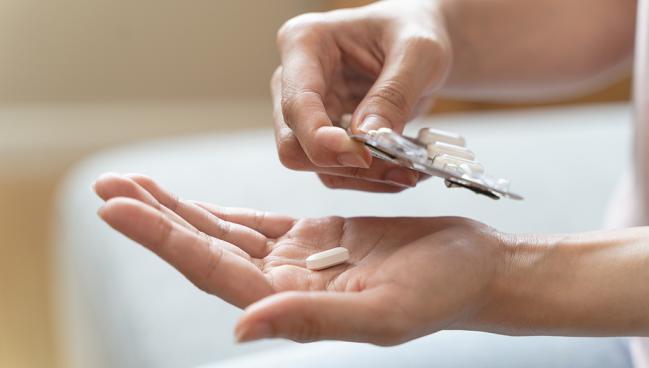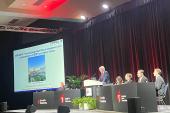STRONG-HF Analysis: Safety Events Common but Manageable in GDMT Optimization
Follow-up visits can identify those who need slower uptitration without labeling them GDMT intolerant, says Zachary Cox.

Patients who had a safety event achieved lower GDMT doses than those who didn’t, said Daniela Tomasoni, MD (University of Brescia, Italy), in her presentation last week at the Heart Failure Society of America (HFSA) 2023 meeting. The results were simultaneously published in the Journal of Cardiac Failure.
“The most common safety indicator was an increase in NT-proBNP levels compared to predischarge levels,” she noted. “Hyperkalemia occurred in 28% of patients, while hypotension, bradycardia, and severe renal dysfunction were less frequent. We observed less than 10% of cases for each.”
Importantly, there were no differences in the primary endpoint of all-cause death or HF readmission at 180 days between patients who did versus did not have a safety indicator, and no association between the individual components of the endpoint and having a safety indicator. Compared with patients who did not have a safety event, those who did had lower systolic BP and a higher heart rate at baseline.
After the presentation, discussant Zachary Cox, PharmD (Lipscomb University College of Pharmacy, Nashville, TN), said the findings are important for clinicians trying to implement rapid uptitration into clinical practice, although more information is needed to refine the understanding of which patients are at highest risk for a safety event.
“So when we incorporate more rapid sequence and simultaneous titration, it's really important that we include these safety monitoring visits that include very basic things: vital signs [and] NT-proBNP,” Cox said. “This is an integral component of this rapid sequence titration strategy.”
Equally important, Cox added, is that “patients with safety events during this should not be labeled as GDMT intolerant necessarily, but [these events] should instead identify patients in whom slower GDMT titration may be needed as opposed to not moving any further.”
Safety Event Rate Nearly 60%
The main STRONG-HF trial showed that rapid uptitration of renin-angiotensin-aldosterone-system (RAAS) inhibitors, beta-blockers, and mineralocorticoid receptor antagonists (MRAs)—under close supervision and with multiple postdischarge visits—lowered the rate of all-cause death or HF readmission at 180 days compared with usual care (15.2% vs 23.3%; P = 0.021) in patients with a recent acute HF hospitalization. The trial was stopped early due to a greater-than-expected benefit of high-intensity therapy after 1,078 patients (mean age 63 years; 39% women) were randomized.
For the post hoc analysis, Tomasoni and colleagues examined data on only those in the rapid uptitration arm of the trial. These patients were prescribed GDMT at > 50% optimal doses within 2 days before anticipated hospital discharge, with uptitration to full optimal doses at 2 weeks postrandomization and/or during the follow-up visits if uptitration was not completed and no safety indicator was met.
According to the protocol, uptitration of ACEi/ARB/ARNIs and/or MRAs was delayed if systolic BP was < 95 mm Hg and/or serum potassium was > 5.0 mmol/L and/or estimated glomerular filtration rate (eGFR) was < 30 mL/min/1.73 m2 at a follow-up visit.
Uptitration to beta-blockers did not occur if heart rate was < 55 bpm and/or systolic BP was < 95 mm Hg. The protocol also included consideration of no uptitration of beta-blockers, but an increase in diuretic dose, if NT-proBNP concentrations were > 10% higher than the predischarge level.
Criteria for one or more of the safety indicators were met in 58% of patients at any follow-up visit between 1 to 6 weeks after discharge. Approximately 40% of those with a safety event had an increase in NT-proBNP concentration > 10% at any postdischarge follow-up visit, 5.2% had eGFR < 30 mL/min/1.73 m2, 9.4% had systolic BP < 95 mm Hg, and 8.5% had heart rate < 55 bpm.
Multiple safety indicators were not uncommon, with 43% of patients with an eGFR < 30 mL/min/1.73 m2 also having a serum potassium > 5.0 mml/L and 57.1% also having NT-proBNP > 10% from predischarge levels. Additionally, 33% of patients with systolic BP < 95 mm Hg also had an increase in NT-proBNP > 10% in any visit.
Overall, patients with versus without any safety indicator were less likely to have history of HF and more likely to present with ACS, have more severe HF symptoms, higher NYHA functional class 1 month before hospital admission, lower systolic BP, and higher heart rate at baseline.
The primary endpoint of 180-day HF readmission or all-cause death occurred in 15% of those with any safety indicator and in 14.2% of those without (P = 0.54).
While no individual safety indicator was associated with the primary endpoint or rates of 180-day mortality, a systolic BP < 95 mm Hg was associated with a trend towards increased death (adjusted HR 2.68; 95% CI 0.94-7.64) and eGFR < 30 mL/min/1.73 m2 was associated with an increased risk of HF readmission (adjusted HR 3.60; 95% CI 1.22-10.60).
Cox said it will be important “to understand the magnitude of change from baseline for a safety event definition in the future analyses.” For clinicians who may not be used to looking at change in NT-proBNP to make a medication adjustment, he asked Tomasoni how to proceed when this change is seen at the first visit after uptitrating a beta-blocker.
“If an increase in NT-proBNP occurred, we need to check for clinical signs of congestion,” she said. “If clinical signs of congestion are present, I would suggest uptitrating loop diuretics. [With regards to] beta-blockers, it’s true that an increase in NT-proBNP levels could be considered as an episode of worsening heart failure, but in our protocol, we did not uptitrate beta-blockers [and instead] we maintained beta-blockers. So, it's important not to stop or downtitrate, but slowly uptitrate beta-blockers.”
L.A. McKeown is a Senior Medical Journalist for TCTMD, the Section Editor of CV Team Forum, and Senior Medical…
Read Full BioSources
Tomasoni D, Davison B, Adamo M, et al. Safety indicators in patients receiving high-intensity care after acute heart failure admission: the STRONG-HF trial. Presented at: HFSA 2023. October 9, 2023. Cleveland, OH.
Disclosures
- Tomasoni reports speaker fees from Boehringer Ingelheim and Alnylam; and grants from Pfizer.





Comments